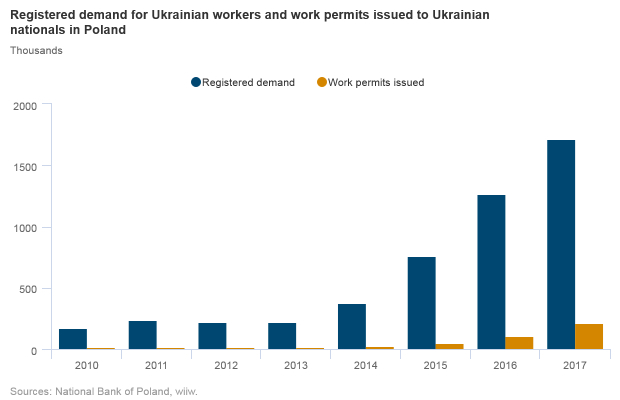Ukrainian workers in Poland: demand by far exceeds supply
03 May 2018
Sharp income differentials and the strength of the Polish economy are likely to ensure that the current trend continues for some time.
By Leon Podkaminer
Photo: Krakow people, Aidan McMichael, CC-BY-NC-2.0
Unemployment in Poland has been receding strongly: the (registered) unemployment rate fell from 13.4% (end-2015) to 6.8% at the end of February 2018. The emerging labour shortages have strengthened demand for foreign workers. As evidenced by official statistics, Polish employers signalled (and registered) the intention to employ over 1.82m foreign workers in 2017, expressing a preference for Ukrainians (1.71m). The respective numbers for 2016 were 1.31m (of which 1.26m were Ukrainians), for 2015 0.78m (0.76m) and for 2014 0.39m (0.37m).
The explosive rise in the demand for foreign – particularly Ukrainian – workers cannot be overlooked. The positions to be filled are primarily short-term (3-6 months), as these constitute about 85% of the offers registered. 56% of the positions offered to prospective Ukrainian workers do not seem to require any identifiable qualifications. The major sectors ready to employ Ukrainians are agriculture (17.6%) followed by manufacturing and construction (12.5% each).
Demand outstripping supply
The demand for foreign (and Ukrainian) workers in Poland remains unsatisfied. According to the official data in 2017, a total of 267,000 new (personalised) work permits were granted, 216,000 of which to Ukrainian nationals. In 2016 a total of 127,000 permits were issued (106,000 of which to Ukrainians). For 2015 the respective number was 66,000 (50,000 to Ukrainians). Of of the permits granted in 2017 to Ukrainians, 56% were for less than 1 year and 44% for more than 1 year (and less than 3 years). Construction permits granted in 2017 accounted for 20% of the total, followed by transportation (13%) and manufacturing (10%). Clearly, there has been a mismatch between the demand and supply not only with respect to the totals but also with respect to its sectoral composition.
The question of how much work is actually being actually performed by foreign (and Ukrainian) workers is rather hard to answer because some work, primarily casual employment in sectors such as agriculture or domestic services, escapes official recording[1]. At the end of the third quarter of 2017, 423,000 foreign employees were registered with the Social Security (ZUS) Authority, of which 308 thousand were Ukrainians (at end-2016 194,000 Ukrainians had been registered).
According to the National Bank of Poland (NBP) about 1 million foreign workers stayed (and presumably worked, for some time at least) in Poland in 2017 – of which 87% were Ukrainians[2]. According to the NBP, in 2015 Ukrainian workers’ remittances were equivalent to EUR 1.2bn, rising to EUR 1.8bn in 2016 and EUR 2bn in the first three quarters of 2017.
Why Ukrainians are in demand
It is clear that Ukrainians are in high demand among Polish employers, and that Poland is (still) the primary destination for the Ukrainian guest workers. There are several reasons for this. Proximity (in geographical, linguistic and cultural terms[3]) seems to be particularly important. This is not the only reasons, however. In particular, the relative income (and wage) positions of the two countries are also key. As long as Poland booms while Ukraine stagnates, one may expect the present trends to continue.
Notes
[1] Almost half of Polish farms (predominantly larger-scale) confess to having employed Ukrainians – primarily in simple and short-term tasks. The polls conducted among these employees suggest they work over 60 hours per week, on average.
[2] See ‘Obywatele Ukrainy pracujacy w Polsce’ (‘Ukrainian Citizens Working in Poland’, NBP, 2018). The Ukrainian Central Statistical Office suggests that at mid-2017 some 303,000 Ukrainian employees were present in Poland. The NBP report quoted above suggests that the actual number is much higher (pp.8-9).
[3] About 85% of migrants come from the Ukrainian-speaking (Western) regions of the country. Until the late 17th century these regions were a part of the Kingdom of Poland.

